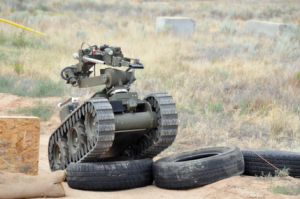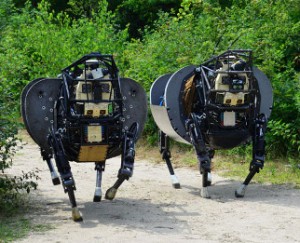
Extreme Hazard robot essaying an obstacle course at the Robotic Vehicle Range, Kirtland AFB, Albuquerque, NM. Sandia National Labs.
A sultry day was in the offing near Purnell OK, the seat of McCurtain County in the state’s southeast quadrant, just a dozen miles northwest from the triple point where Arkansas, Texas and Oklahoma meet. One hundred forty miles northeast, the National Weather Service Doppler radar station KSRX at Ft. Smith Arkansas, was monitoring a cold front approaching from the west, driven by a mass of cool dry air sweeping down from the northern plains. Typical for the late spring in the American prairie, this eastbound mass was colliding with a warm, wet air mass streaming north from the Gulf of Mexico, now roiling under a cool dry tongue at 700 mb. Buoyant but trapped under heavier cool air, supercells were forming in the humid 850 mb surface layer twenty miles west of Purnell.
Late in the afternoon Fort Smith meteorologists saw a tell-tale hook echo curl around west of Purnell and issued a short-fused tornado watch for McCurtain County. But a multi-vortex Enhanced Fujita-5 twister had already touched down three miles east of Oklahoma State 37, brushed north of the Bokoma Nuclear Generator Facility on the Red River and arced north east. It plowed through the central business district of Purnell and over the course of fifteen minutes leveled downtown, killing and maiming scores. Power lines snapped, plunging eastern McCurtain County into darkness, but the most unsettling after effect occurred at Bokoma. Though the plant missed the full fury of the tornado, wind-blown debris driven nearly two hundred miles per hour smashed through protective cages and into the roof-mounted radiators of diesel circulating pumps, which soon overheated and failed. Before control rods could fully shut it down, core temperatures surged, triggering a partial meltdown in Bokoma Unit One. Into conditions unbearable to a human trundled a camera wielding robot.
♣ ♣ ♣
The good thing about the Oklahoma tragedy, as readers from the Sooner State recognize, is that neither Purnell or the Bokoma Nuclear Generating Facility exist. To planners of Robot Rodeos, however, what could happen is far more important than what has happened. The tornado-struck nuclear power plant served as one of the scenarios for a 2011 Robot Rodeo hosted by Sandia National Laboratory in Albuquerque, NM and was akin to the (very real) EF-2 tornado-strike of the Davis-Besse Nuclear Generating Facility at Oak Harbor, OH, in 1998.
Over the last ten years robotics have assumed increasingly key roles in piloting drone aircraft, furnishing battlefield support or, in disaster scenarios, going where no first responders dare to go. Robots go into conditions that would kill people, and not nearly as much grief arises if a robot succumbs to extreme conditions. Increasingly, the limiting factor in a robot’s effectiveness is not its hardware or software but its operator. It takes practice to run a robot, yet – unless disaster strikes – realistic practice opportunities hardly exist. Hence, the up-tick in Robot Rodeos, which stage ersatz disasters to challenge operators and their mechanical charges alike.
One of the longer running robot rodeos in the short history of the sport is hosted every year at either Los Alamos National Laboratory in the northern high desert of New Mexico or at the Sandia National Laboratory in Albuquerque NM, where the seventh edition of the Western National Robot Rodeo was staged between June 17 and 21 2013. Said Chris Ory of Los Alamos Emergency Response Group: “They [attendees] get a chance to for some training because sometimes they just don’t get the ability during their day-to-day operations to just go out and train for a week using robots.”
In recent years, the National labs’ robot rodeos have drawn attendees mainly from civilian police departments from as far away as New Jersey. Eighteen teams attended the 2012 robot rodeo at Los Alamos National Laboratory. Each team ran a gamut of ten scenarios, kept secret until assigned at the rodeo. Scenarios run the spectrum from the (expected) defusing of improvised explosive devices to a wry mixing of pancake batter from scratch in sufficient quantities to serve a panel of three judges.
“Every year since its inception, the Robot Rodeo coordinators have made the scenarios increasingly complex, so it gives us a great chance to practice our skills and introduce new members of our team to different situations,” said Sgt. Jose Salazar, commander of the New Mexico State Police Bomb Squad, “At the same time, we get to see what the robots are capable of and the vendors give us the chance to see what new technologies are on the market.”
The robot rodeos at the National Laboratories mainly simulate situations that law enforcement or civilian first responder teams would encounter. These teams generally use commercial, off the shelf “extreme hazard” robots, units costing anywhere from $30,000 to $200,000 USD. These kinds of robots have limited self-direction capability and usually need a link to a laptop-wielding operator to be fully effective. These kinds of robots do not operate at the edge of theory; they are conservatively built to perform solidly for operators who are not rocket – or robotic – scientists, but are police officers or emergency response personnel.
Robotic scientists play at the Sandia‘s Intelligent Systems and Robotics Center (ISRC), where serious robotics research and testing takes place at the nearby Robotic Vehicle Range at Kirtland AFB. These are research robots, one-offs built at the center’s Mobile Robotics Department, and are designed mainly to test advanced robotics theory.
Fort Benning GA hosts a yearly Robot Rodeo of a very different character: one for robots working in the field of battle. It’s Robotics Rodeo has been held three times to date; the latest rodeo having occurred in June, 2012. Private sector vendors participate in Fort Benning’s rodeo and promote the battlefield readiness of their robotic wares for U. S. Army personnel. As with the national laboratory rodeo counterparts, the robots looking for military enlistment at Fort Benning are technology tested machines, not cutting edge designs, and are intended to be used by soldiers, not research scientists.

A pair of LS3 robots developed by Boston Dynamics use articulated limbs instead of wheels. Boston Dynamics
In parallel with the national laboratories, military robotics also has research efforts under way. Some of the more intriguing efforts abandon wheels and treads for articulated limbs, hearkening back to Rossum’s Universal Robots. Recently, Boston Dynamics, under contract with the Marine Corps War Fighting Lab and the Defense Advance Research Project Agency (DARPA), unveiled its Legged Squad Support System(LS3). Touted as a nearly fully autonomous robot, LS3 can carry 400 lbs. of equipment and run for two days between refuelings. Onboard optical sensors enable LS3 to obediently follow a Marine like a dog or, if need be, strike out on its own.Despite its delicate seeming legs, LS3 is remarkably sure footed, and, if it does topple over, it is capable of righting itself, something that wheeled robotics cannot do.
The LS3 looks, unsettlingly perhaps, like a headless horse. Using articulated legs instead of wheels enable the LS3 to go over any terrain that quadrupeds could traverse and which inevitably, perhaps, induces wags to wonder if the LS3 isn’t just an expensive remake of the venerable Army pack mule. Being a research prototype, it is somewhat misleading to compare the LS3 with an old, well established technology such as an Army pack mule, which, as my great grand uncle would point out, did not necessarily follow soldiers obediently like dogs, and which, in any case, would fold as quickly as any biological in sarin laced phosgene oxime clouds, while fleshless quadrupeds like LS3 would trundle on.